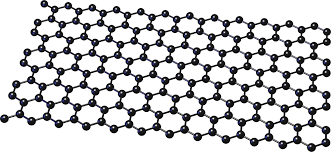Graphene is one of the strongest materials in the world. It's a two-dimensional structure (insofar the overall extension in three dimensions is concerned):
A pencil contains graphite, which is a stacking of graphene layers. The layers are held together by single-electron bindings between carbon atoms while the bindings involved in producing the layer itself are two-electron bindings that are much stronger. Two layers can slide over each other. But why is it so easy to break a pencil? Supposedly graphene can hold a (micro) bullet (see here).
So why wouldn't stacked graphene (like in my pencil) be able to withstand a real bullet? Why can't my pencil resist the applied force when I try to break it (or pull it apart but this will require a bigger force)? Is it because the whole structure of graphite in my pencil is composed of smaller pieces of graphite? Is it because the force I apply is bigger than the total of the two-electron bondings holding all layers of graphene together? Is it because in breaking something a leverage effect is introduced? Or what?
Maybe I should rephrase my question. Is it easy to break a collection macroscopic sized graphene layers, hold together by relatively small bindings (as compared to the bonding required to keep the C-atoms of the layer together)? Say the layers have the same area (in form and size) as that of the (length) cross-section of the black inside of the pencil, and the layers are stacked to a height that is the same as the diameter of the black inside. I can imagine that if I had a piece of diamond of that form, the piece would break easy. But why?

